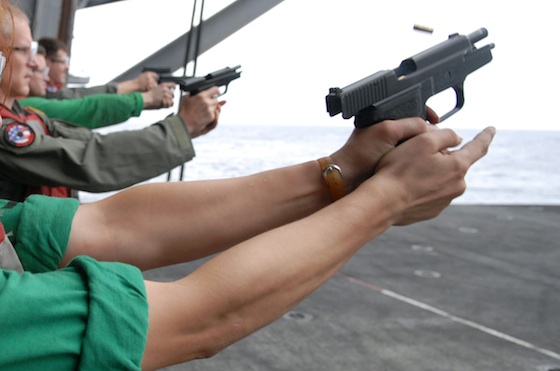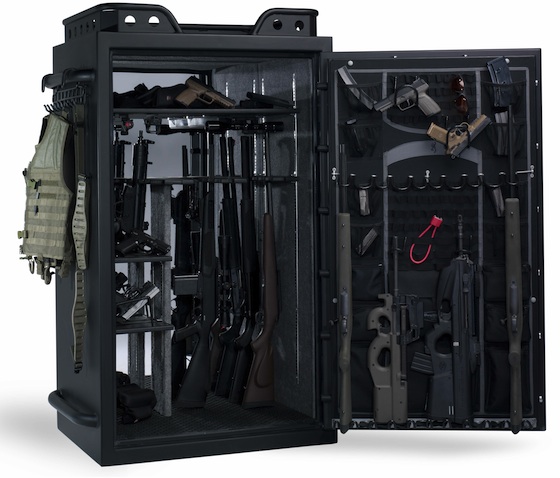Air Gun and General Gun Safety Tips

Disclaimer:
"This article is only intended as a guide and may not be 100% accurate, please check your areas gun laws and regulations for more information on this subject."
I want to talk about two very important Air Gun safety topics (Any gun for that matter). Those two topics are: Handling and Storing your guns.
In Canada we are required by law to take a gun operation and safety course in order to get our PAL (Possessions and Acquisitions) license. A PAL license is required to purchase firearms and ammunition but is not necessary for most BB and Pellet guns that shoot under 500 fps. Personally, I think a firearms course is a great idea for anyone to take, even if you don't plan on getting a gun but you maybe have some interest or concerns about guns.
The biggest problem with guns is the ignorance surrounding them. I'm not saying people who don't like guns are stupid, but rather that in many cases they simply don't understand guns and it scares them. What's even worse than this is when a firearms owner has no idea on how to properly handle and store their firearms. When you put both of these scenarios together you get a bad combination that in turn makes it more difficult for pro-gun and anti-gun advocates to see eye to eye.
I definitely don't want to start a debate on this issue but rather provide safety information for those choosing to own and operate guns.

General Gun Handling Tips:
- Make sure you understand your areas gun handling laws.
- Safety check your gun - Make sure your gun is unloaded (visual inspection) at all times unless you are ready to shoot it. (If you use the gun for home or personal defense and need it to be loaded at all times, make sure to keep it securely holstered or stored in a safe manor so that it does not fall into the wrong hands)
- Get familiar with your gun while it is unloaded, read the owners manual, learn the workings and features of your gun until you are comfortable with it.
- If your gun has a safety make sure you know how to operate it but do not become dependent on the safety alone.
- Always wear eye protection and if your gun is loud, use appropriate ear protection.
- Treat your gun likes it's loaded and off of safe mode at all times. The most dangerous gun is one that is believed to be unloaded. Many people treat unloaded guns with less respect than they do a loaded gun and pay a severe price for it when they find out the gun was actually loaded.
- Only place your finger on the trigger of the gun when you are ready to shoot at your target. The best safety feature on any gun is your trigger finger. When you are not shooting, place your finger across the trigger guard, this acts as a physical barrier helping to protect the trigger from an accidental or unintentional misfire.
- If you are holding the gun but it is not in use, point it slightly forward but mostly toward the ground. When on a gun range, keep your gun pointed down-range in the direction of the target at all times.
- Always know what is behind and beyond your target and never shoot over the crest of a hill. Some ammunition can travel several miles and still be dangerous. Even a pellet or BB if shot upwards at a slight angle can travel a few hundred yard and impact a person with enough energy to inflict harm.
- Don't use your scope as a pair of binoculars to see what is out there. Use binoculars, that's what they are for. Would you like to be at the receiving end of a set of cross-hairs?
- When you are finished using your gun remove the ammunition, safety check and secure it.

Gun Storage Tips:
- Make sure you understand your areas gun storage laws.
- In Canada most air guns that shoot under 500 fps are not required to abide by the same storage laws as licensed firearms but practicing safe gun storage for any gun is always a good idea.
- Safety check your gun - Make sure your gun is unloaded (visual inspection) before placing in storage.
- Make sure to have at least one level of lock prevention, this could be a gun safe or a gun trigger lock or cable lock. I recommend using a trigger lock on your gun and placing it in a gun safe. Keep your gun safe or case keys in a secure area out of sight.
- Keep your ammunition and firearms in different locations. This is not necessary in Canada but a good general idea.
- Keep your firearms out of sight and keep the temptation out of the picture.
- If you have a dedicated home defense gun that you want easy access to, keep it in a gun safe beside your bed with an easily accessible touchpad combination lock. You can have a loaded magazine in the safe with your gun, just not in the gun. (This scenario is Canada Gun Law Friendly!)
- Gun storage laws when transporting your firearm are often different than when storing a gun in your home, make sure you understand these laws in your area. For example: In Canada we have to have an "ATT" transportation permit (Authorization to Transport) that allows a gun holder to transport their firearm from their home and to the range and/or to a gun smith. Any detours from point A to point B must be within reason. (No dropping by the bar on the way home from the gun range) Furthermore, licensed pistols must be unloaded and trigger locked in a hard shell case that also has a lock on it. Ammunition is not allowed in the case with the gun in transport and your gun needs to be in the trunk of your car or in an out of sight area if you have a truck.
Hopefully you have gotten at least something out of this gun handling and storage awareness article. My hope is that many of you will take this to heart and if you don't already practice safe gun handling and storage, you will start today!
Related Links:
Please feel free to spread the word and link to this Article and YouTube video on the same subject.
Here is my YouTube Video on Air Gun and General Gun Safety Tips:
Click on Links/Photos below to BUY related Gun Safety items:



